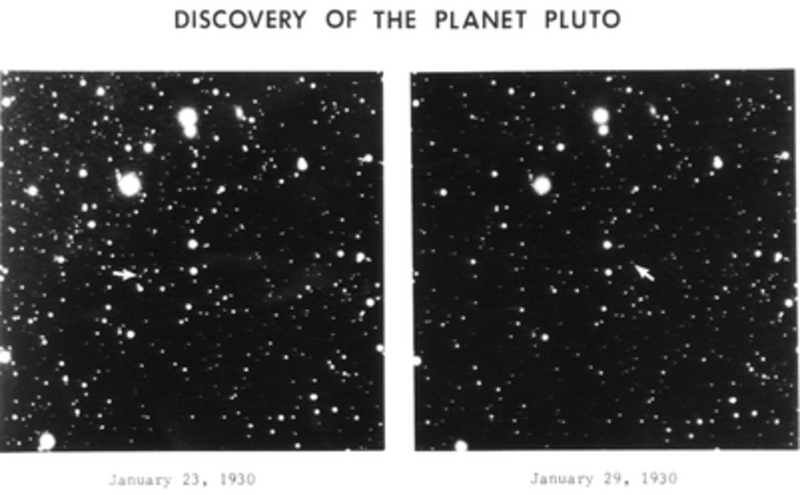Here are Pluto's orbital elements.
a = 39.4820851 AU
e = 0.2488325
i = 17.1400169 deg
Ω = 110.3027527 deg
ω = 113.7620984 deg
T = JD 2447799.584
On 25 December 2008 at 12h UT the time will be
t = JD 2454826.0
(JD means "Julian date." It's a running count of days began in ancient times.)
You must do the following math (between BEGIN and END) for Pluto.
BEGIN
Find the period, P, of the orbit in days.
P = (365.256898326 days) a^1.5
Find the mean anomaly, m, of the orbit at time t.
m = 2π (t − T) / P
Adjust m to the interval [0, 2π

.
Find the eccentric anomaly, u. (Danby's method is shown.)
U1 = m
REPEAT...
. U0 = U1
. F0 = U0 − e sin U0 − m
. F1 = 1 − e cos U0
. F2 = e sin U0
. F3 = e cos U0
. D1 = −F0 / F1
. D2 = −F0 / [ F1 + D1 F2 / 2 ]
. D3 = −F0 / [ F1 + D1 F2 / 2 + (D2)^2 F3 / 6 ]
. U1 = U0 + D3
UNTIL |U1−U0| < 1E−15
u = U1
Note: The mean anomaly, m, must be in radians as you go through the repeat-loop, just above. The eccentric anomaly, u, will emerge in radians, as well.
Find the canonical (triple prime) heliocentric position vector.
x''' = a (cos u − e)
y''' = a sin u sqrt (1 − e^2)
z''' = 0
Rotate the triple-prime position vector by the argument of the perihelion, ω.
x'' = x''' cos ω − y''' sin ω
y'' = x''' sin ω + y''' cos ω
z'' = z''' = 0
Rotate the double-prime position vector by the inclination, i.
x' = x''
y' = y'' cos i
z' = y'' sin i
Rotate the single-prime position vector by the longitude of the ascending node, Ω.
x = x' cos Ω − y' sin Ω
y = x' sin Ω + y' cos Ω
z = z'
The unprimed position vector is the position in heliocentric ecliptic coordinates.
r = sqrt ( x^2 + y^2 + z^2 )
END
That gives you Pluto's position vector with respect to the sun, in ecliptic coordinates: x,y,z.
To get Pluto's geocentric position vector in celestial spherical coordinates, you have to go further.
Here are orbital elements for the Earth-Moon barycenter.
a = 1.00000317 AU
e = 0.0167068
i = −0.0013107 deg
Ω = 0.0
ω = 102.9700270 deg
T = JD 2455198.606
Follow the BEGIN to END procedure above, except using Earth's orbital elements this time, instead of Pluto's. When you're finished, assign Earth's position vector a subscript of 1 and Pluto's position vector a subscript of 2. Then do as follows:
dx = x2 − x1
dy = y2 − y1
dz = z2 − z1
t0 = t − 2451545
ε = 23.4392911 − (3.562266E−7) t0 − (1.228E−16) t0^2 + (1.0335E−20) t0^3
ε = Earth's obliquity in degrees.
dx' = dx
dy' = dy cos ε − dz sin ε
dz' = dy sin ε + dz cos ε
dr = sqrt [ (dx')^2 + (dy')^2 + (dz')^2 ]
RA = Arctan ( dy' , dx' )
dec = Arcsin ( dz' / dr )
And adjust the angular units to your taste.
Definition of the two-argument Arctan function.
atn(z) = single argument Arctan function of the argument z.
Function Arctan( y , x )
. if x = 0 and y > 0 then angle = +π/2
. if x = 0 and y = 0 then angle = 0
. if x = 0 and y < 0 then angle = −π/2
. if x < 0 then angle = atn(y/x) + π
. if x > 0 and y > 0 then angle = atn(y/x)
. if x > 0 and y < 0 then angle = atn(y/x) + 2π
Arctan = angle
If you do all the above, you can find out that at noon in Greenwich, England, on Christmas Day 2008, Pluto's position was:
(Heliocentric ecliptic rectangular vector)
x = +0.44377 AU
y = −31.40248 AU
z = +3.23204 AU
The sign difference on the x and y components of that vector, between my figures and those of MorningFoxNorth, are the result of the fact that we take opposite directions as positive for those axes. My +x is in the direction of the Vernal Equinox. His appears to be in the direction of the Autumnal Equinox. Our +y axes are chosen, in either case, to keep the coordinate system right-handed.
(Geocentric celestial spherical vector)
dr = 32.546774 AU
RA = 18h 3m 58s
dec = −17d 44' 27"





 I really have no excuse.
I really have no excuse.  .
.